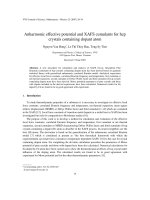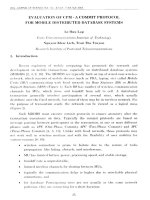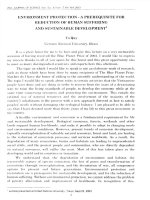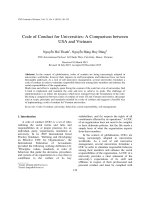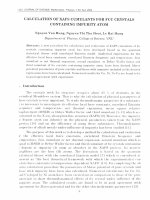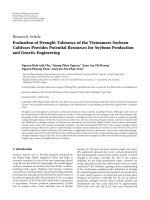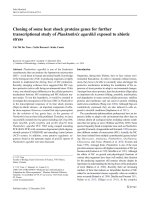DSpace at VNU: Calculation of XAFS Cumulants for FCC Crystals Containing Impurity Atom
Bạn đang xem bản rút gọn của tài liệu. Xem và tải ngay bản đầy đủ của tài liệu tại đây (2.84 MB, 8 trang )
\N1U JOURNAL OF SCIENCE, Mathematics - Physics,
T.xx.
N03, 2004
CA LC U LA TIO N O F X A F S CƯMULANTS F O R F C C CRYSTALS
C O N T A IN IN G IM P U R IT Y ATOM
N g u y e n V a n H u n g , N g u y e n T h i T h u H o a i, L e H a i H u n g
D e p a rtm e n t o f P h ysics, College o f Science, V N U
A b s tra c t: A new procedure for calculation and evaluation of XAFS cumulants of fee
crystals containing impurity atom has been developed based on the quantum
statistical theory with correlated Einstein model. Analytical expressions for the
effective local force constants, correlated Einstein frequency and temperature, first
cumulant or net thermal expansion, second cumulant or Debye Waller factor and
third cumulant of fee crystals containing impurity atom have been derived. Morse
potential param eters of pure crystals and those with impurity included in the derived
expressions have been calculated. Numerical results for Cu. Ni. Ni-Cu are found to be
in good agreement with experiment.
.
In tro d u c tio n
T he c r y s ta ls w ith fee s t r u c t u r e occupies a b o u t 25 % of e le m e n ts in the
)eriodical M en d eleev sy stem . T h a t is why th e c a lc u la tio n of phy sical p a r a m e te r s of
h e s e c ry s ta ls is very im p o rta n t. To s tu d y th e r m o d y n a m ic p r o p e rtie s of a su b sta n c e
t is n e c e s sa ry to in v e s tig a te its effective local force c o n s ta n ts , c o rre la te d E in s te in
re q u e n c y an d t e m p e r a t u r e , net th e r m a l e x p a n sio n , m e a n s q u a re relativ e
lisp la c e m e n t (MSRD) or Debye W aller factor an d th ird c u m u l a n t [1-13] which arc*
o n ta in e d in th e X -ray a b s o rp tio n fine s tr u c t u r e (XAFS) [9J. M oreover, th e im p u rity
>r d o p a n t ato m can in fu e n ce on th e p h y sica l p a r a m e t e r s t a k e n from th e XAFS
p e c tr a 110] a n d on th e efficiency of u s in g th e s e s u b s ta n c e s . T h e rm o d y n a m ic
>roperties of alk ali m e ta ls u n d e r in flu en c e of im p u rity h a s b e e n s tu d ie d [ 1 1 ].
T he p u rp o se of th is w ork is to develop a m eth o d for c a lc u la tio n an d e v a lu a tio n
>f th e effective local force c o n s ta n ts , c o rre la te d E in s te in frequency an d
e m p e r a tu r e , firs t c u m u l a n t or n e t th e r m a l ex p an sio n , second c u m u la n t which IS
•qual to MSRD or Debve W a lle r facto r an d th ird c u m u la n t of fee c r y s ta ls c o n ta in in g
I d o p a n t or i m p u rity (I) ato m as a b s o rb e r in th e XAFS process. Its n e a r e s t
leig hb ors a re the h o st (H) a to m s. T he d e riv a tio n is b a s e d on th e q u a n tu m
statistical th eo ry w ith th e c o rre la te d E in s te in model [7] w hich is considered at
jre s e n t as “th e b e s t th e o r e tic a l fra m e w o rk w ith which th e e x p e r im e n ta lis t can
e la te force c o n s ta n ts to t e m p e r a t u r e d e p e n d e n t XAFS" [ 1 0 ]. Kor co m p leting th e ab
nitio ca lc u la tio n p ro c e d u re th e p a r a m e t e r s of M orse p o te n tia l of p u re c ry sta ls and
hose w ith im p u rity h a v e b een also c a lc u la te d . N u m e ric a l c a lc u la tio n s for Cu. Ni.
md Cu doped by Ni ato m h ave b een c a rrie d o u t in c o m p a riso n to th o se of Lh(' p u re
n a t e r i a l s to show th e r m o d y n a m ic a l effects of fee c r y s ta l u n d e r influence of th e
m p u rity ato m . T he c a lc u la te d r e s u l ts a re found to be in good a g r e e m e n t w ith
'X perim ent for M orse p o te n tia l a n d for th e o th e r th e r m o d y n a m ic p a r a m e t e r s [13].
9
C alcu la tion of XAFS c u m u l a n t s for fee.
2. F o r m a l i s m
T he ex p re ssio n for th e MSRD in XAFS th e o ry is d e riv e d b ased on th e
a n h a r m o n ic c o rre la te d E in s te in model [7] acco rding to w h ich th e effective
in te ra c tio n E in s te in p o te n tia l of the s y ste m c o n s is tin g of a n i m p u r ity (I) ato m as
a b s o rb e r an d th e o th e r h o st (H) ato m s is given by
~aT x R ' 2 'R, i '
i'c/f(x ) - - l
1
>
/■*/
M ị +M„
( 1)
H ere X is d e v ia tio n b e tw e e n th e i n s t a n t a n e o u s bond le n g th r a n d its eq u ilib riu m
value r „ , kcfJ is effective local force c o n s ta n t, a n d ky th e cubic p a r a m e t e r giving an
a s y m m e tr y in th e p a ir d i s tr ib u tio n function, R is bond u n i t vector. T h e c o rrelated
E in s te in model m ay be d efined as a oscillation of a p a i r of a to m s w ith m a ss e s M ị
an d MH (e.g., of i m p u rity ato m a s a b s o rb e r a n d of h o s t a to m as b a c k s c a tte r e r ) in a
given system . T h e ir o scillatio n is in flu enced by th e ir n e ig h b o rs given by th e last
te rm in the l e f t- h a n d side of Eq. (1), w h ere th e s u m / is over a b s o rb e r (/ = 1) and
b a r k s c a t t e r e r 0 = 2 ), a n d th e su m j is over all th e ir n e a r e s t n eig h b o rs, excluding
th e a b s o rb e r a n d b a c k s c tte r e r th e m se lv e s . T h e l a t t e r c o n tr ib u tio n s a re d escrib ed Ly
th e te rm vm (v).
For w eak a n h a r m o n ic ity in th e XAFS process th e M orse p o t e n ti a l is given by
I ho e x p an sio n
V(x) =
d {Lr2 u '
- 2 c ) = d ( - 1 + a 2.x2 - e r V + ■•■)
(2)
for th e p u re m a te r ia l an d
V/If ( v) “ D jii (-1 + ơ Jịị -V —aj Hx H )
0)
for the case w ith im p u rity , w h e re M orse p o te n tia l p a r a m e t e r s h a v e b een obtained
by a v e ra g in g th o se of th e p u r e m a te r ia ls a n d are given by
r,
D l + D ll
„2
D'" ’
D l a i + D Ha H
=
D , * 0„
3 _ D l a ) + D H a hl
■
D, + D„
(1\
■
U sin g th e d e fin itio n [2, 7] V= A' - ứ as th e d e v ia tio n from th e equilibrium
v alu e of X th e Eq. (1) is r e w r it t e n in th e su m of th e h a rm o n ic c o n tr ib u tio n an d tie
(inh arm on ic c o n tr ib u tio n ỔV a s a p u r tu r b a t i o n
Ctrl'2 +5V ■
(5)
T a k in g in to ac c o u n t th e atom ic d is tr ib u tio n of fee c r y s ta l a n d u s in g th e abo/e
e q u a tio n s we o b ta in th e effective local force c o n s ta n t
Kir = 2 Dm a ///[1 + 3(//,2 +/jị)] + ị o Ha ị = /.ưoị,
th e cubic a n h a r m o n ic p a r a m e t e r
6,
10
N g u y e n Van H u n g , N g u y e n Th i T h u H o a i , Le H a i H u n g
ky —Dm ct'm (1 + //|' + // 2 ),
ơ)
the a n h a r m o n ic c o n tr ib u tio n to th e effective p o te n tia l of th e s y ste m
SV(y) = 2 DIHaj H(\ + 3( rì + v l ) ) + ^ D flaj f ay - DIHcc]H{\ + r ì + f . i ị ) Ý
(8)
the c o rre la te d E in s te in freq u en cy
I2
(9)
Dm a m [1 + 1(MỈ + MÌ)] + ị DHa l
[f*
and th e c o rre la te d E in s te in t e m p e r a t u r e
Dịh&Ĩh D + 3(//f + M i)]+
k B [//
2
^
H a ~H
( 10 )
M
M , +M /7
(11)
w here
M.
M , +M //
,
//2
M,
Mj + M h
//2 =
T h e c u m u l a n t s h av e b een d erived by a v e r a g in g p ro ced u re, u sin g th e
s ta tis tic a l d e n s ity m a tr ix /9 an d th e cano nical p a r titio n fu n c tio n z in th e form
< y m > = - T r ( p y m), m = 1 ,2 ,3 ,'Zd
,
( 12 )
Z = Trp, p = p 0 +ổp, Z * Z 0 =Trpa ,
(13)
p 0 =e - fiHo, H 0 = ậ - + ị - k eíry 2, fi = \ / k BT
2 // 2
(14)
where k B is Boltzmann constant and ỏp is neglected due to small anharmonicity in XAFS [2].
U sing theÍ above re su lts we calculate the second c u m u la n t or DebyeDebye-W aller factor
(15)
Ơ
w h ere we e x p re ss y in te r m s of a n ih ila tio n an d c re a tio n o p e r a to rs , à an d (1 +, i. e.
V = K{ « + « •);
K~’ =
*
(16)
\JLIO)e
an d use h a rm o n ic o sc illa to r s ta te In) w ith e ig e n v a lu e En = nh( 0 E (ignoring th e zero
point en erg y for convenience).
T herefo re, th e e x p re s s io n for second c u m u la n t (MSRD) or D eb y e-W aller factor
is re s u lte d as
ơ ~= Ơ
(1 + z)
( 1 -z)
Ơ.
PiCOr
(17)
11
C alcu la tion of XAFS c u m u l a n t s for fee.
Now we c a lc u la te th e odd c u m u la n ts
! ^ e-0 E ._ e-pE„.
(18)
Ơ
0
U sin g th e c a lc u la te d m a trix e le m e n ts a n d m a th e m a tic a l fo rm u la s for differen t
tr a n s f o rm a tio n s we o b ta in th e e x p re ssio n s for th e first c u m u l a n t (m —1 )
(I)
i 1 + r) J (l)uyi ) —u () _
x , V ()
(l-z )
3Dw g ///(l + //|3 +/<23) ^ ------Ị-!
(19)
DiHa ĨH(1 + 3/'|2 + Ml ) + 2
an d for th e t h i r d c u m u l a n t (m=3)
n O) = (3 ) (l + ioz + z2) .
D ihGIH
(3 ) =
(1 - 2 )
M\
DiHa ìn (1 + 3/'|2 +
/^2 )
(20)
) + 9 D Ha~H
In th e above e x p re s s io n s ơ i '1, <7 02 , ơ i ’ 1 are z e ro -p o in t c o n tr ib u tio n s to th e first,
second a n d t h i r d c u m u la n ts , resp ectively . T hey c h a r a c te r iz e q u a n t u m effects
occurred by u s in g q u a n t u m th e o ry in ou r c a lc u la tio n a n d in flu e n c e on th e o b tain ed
r e su lts. T h e above d e riv e d c u m u l a n t s are c o n ta in e d in th e XAFS in clu d in g
a n h a r m o n ic c o n tr ib u tio n s [9].
3. N u m e r i c a l r e s u l t s a n d c o m p a r i s o n t o e x p e r i m e n t
Now we a p p ly th e d eriv ed e x p re ssio n s to n u m e ric a l c a lc u la tio n s for Cu, Ni
an d Cu doped by Ni a to m as a b s o rb e r in th e XAFS process. T h e ir M orse p o te n tia l
p a r a m e t e r s h av e b e e n c a lc u la te d u s in g th e p ro ced u re p r e s e n t e d in [16]. The
calcu lated v a lu e s of M orse p o te n tia l p a r a m e te r s ; c o rre la te d E i n s te i n freq uency an d
te m p e r a tu r e ; effective local force c o n s ta n t for th e p u r e Cu, Ni a n d th o se doped by
N i ato m a re w r itt e n in T a b le I. T h ey are found to be in good a g r e e m e n t w ith
e x p e r im e n t [13].
T a b l e I C a lc u la te d v a lu e s of M orse p o te n tia l p a r a m e t e r s D, a ; c o rre la te d E in s te in
frequency z , a n d t e m p e r a t u r e eE\ effective local force c o n s ta n t keff for N i-N i, CuCu, N i-C u in c o m p a riso n to e x p e r im e n t [13].
k ef f { N / m )
_____
10 13 Hz )
D(eV)
a ( A ’)
Ni-Ni, present
0.4263
1.3819
2.8033
65.2158
3'. 64 73
278.6038
Ni-Ni, exp.[ 13]
0.4100
1.3900
2.9035
63.4596
3.5979
274.8271
Cu-Cu, present
0.3367
1.3549
2.8701
49.5156
3.0544
233.3151
Cu-Cu, exp.[13]
0.3300
1.3800
2.9802
50.3450
3.0799
235.2661
N i - Cu , p r e s e n t
0.3817
1.3928
2.9537
60.1340
3.4348
262.3749
Ni-Cu, exp.[ 13]
0.3700
1.3855
2.9337
57.8621
3.3693
257.3708
Bond
r„ ( Ả )
o >e
(x
12
N g u y e n V a n H u n g , N g u y e n T h i T h u H o a i , Le H a i H u n g
F ig u r e 1 i l l u s t r a t e s o u r c a lc u la te d M o rse p o t e n t i a l s of Cu, Ni a n d of Cu
d o p p ed by Ni a to m w h ic h a g r e e s w ell w ith th e e x p e r i m e n t a l r e s u l t [13].
r(A°)
Figure 1: Morse potentials of Cu, Ni and Cu doped by Ni atom compared to experiment [13].
Figure 2: T e m p e ra tu r e depend ence of our calcu lated first c u m u la n t c r ^ ( r ) of Cu (dashdot), Ni (dash) and of Cu doped by Ni atom (solid) co m pared to e x p e rim e n t (dot) [13].
13
Calcu la ti on o f XA FS c u m u l a n t s for fee.
F igure 3: Tem perature dependence of our calculated second cu m ulan t
ơ
{t ) of Cu (dash-
dot), Ni (dash) and of Cu doped by Ni atom (solid) compared to experim ent (dot) [13].
X1Q'4
T(K)
Figure 4: T em perature dependence of our calculated third cum u lant cr '^(r) of Cu (dash”
dot), Ni (dash) and of Cu doped by Ni atom (solid) compared to experim ent (dot) [13].
14
N g u y e n Van H u n g , N g u y e n T h i T h u H o a i , Le H a i H u n g
T he t e m p e r a t u r e d e p e n d e n c e of o u r c a lc u la te d f ir s t c u m u l a n t or n e t th e r m a l
e x p a n s io n ơ-(l)( ĩ) (F ig u re 2), second c u m u l a n t or D e b y e - W a lle r fa c to r
3) an d th ird c u m u l a n t c r ^ ( r )
ơ 2(t )
(Figure
(F ig u re 4) sh o w s s ig n if ic a n t c h a n g e s of th e s e values
w h en Cu is dopped by Ni ato m a n d a r e a s o n a b le a g r e e m e n t b e tw e e n th e calcu lated
by th e p r e s e n t th e o ry a n d e x p e r im e n ta l v a lu e s . F i g u r e s 2, 3, 4 show t h a t the
c u m u la n ts of Cu becom e w e a k e r due to th e d o p a n t by Ni a to m . T h e s e i m p u 'r ity
effects are very i m p o r t a n t a n d th e y h av e to be t a k e n in to a c c o u n t in the e v a lu a tio n
of th e rm o d y n a m ic p r o p e rtie s of the s u b s ta n c e s . T h e c a lc u l a t e d first, second an d
th ird c u m u la n t c o n ta in in g i m p u rity a to m also s a tis f y a ll i m p o r t a n t p ro p e rtie s
discovered in th e o ry [7, 17] an d e x p e r im e n t [ 1 ]. T h e y c o n ta in zero -p o in t
co n trib u tio n a t low t e m p e r a t u r e an d a p p r o a c h th e c la s s ic a l th e o r y r e s u l ts a t high
t e m p e r a tu r e , i., e., th e p r o p o rtio n a lity to th e h ig h t e m p e r a t u r e is l i n e a r for th e first
a n d second c u m u l a n t a n d q u a d r a tic a l for th e t h i r d c u m u l a n t .
4.
C o n c lu sio n s
A new a n a ly tic a l m eth o d for c a lc u la tio n a n d e v a l u a t i o n of th e rm o d y n a m ic
p ro p e rtie s of th e fee c r y s ta ls c o n ta in in g i m p u r i ty a to m h a s b e e n d ev elop ed b ased on
th e q u a n t u m s ta ti s t i c a l th e o ry w ith c o r re la te d E i n s t e i n m odel.
O u r d e v e lo p m e n t is th e d e riv a tio n of th e a n a l y t i c a l e x p r e s s io n s for th e local
effective force c o n s ta n ts , c o rre la te d E i n s t e i n fre q u e n c y a n d t e m p e r a t u r e , th e first,
second an d th ird XAFS c u m u l a n t of fee c r y s ta ls c o n t a i n i n g i m p u r i t y atom . T hey are
sig n ifican tly d iffe re n t from th ose of t h e p u r e m a t e r i a l s , b u t s a tis f y all s ta n d a r d
p ro p e rtie s of th e se q u a n titie s . T h e se d iffe re n c e s d e n o te t h e i m p u r i t y effects which
discovered in e x p e r im e n t a n d th ey h a v e to be t a k e n in to a c c o u n t in th e e v a lu a tio n
of th e rm o d y n a m ic p r o p e rtie s of th e s u b s ta n c e s .
M orse p o te n tia l p a r a m e t e r s h a v e b e e n a lso a n a l y t i c a l l y c a lc u la te d th u s
co m p letin g th e ab in itio c a lc u la tio n p ro c e d u re of t h e c o n s id e re d v alu es.
The good a g r e e m e n t b e tw e e n th e c a lc u la te d a n d t h e e x p e r im e n t a l re s u lts
d e m o n s tr a te s th e efficiency a n d p o ssib ility of u s in g th e p r e s e n t d ev elo p ed pro ced ure
in XAFS d a t a a n a ly s is .
A c k n o w l e d g m e n t s . One of th e a u t h o r s (N. V. H u n g ) t h a n k s Dr. I. V. Pirog
for s e n d in g Ref. 13 a n d p ro v id in g th e e x p e r i m e n t a l d a t a . T h i s w ork is s u p p o rte d in
p a r t by th e basic science r e s e a r c h n a tio n a l p r o g r a m p r o v id e d by th e M in istry of
Science a n d Technology No. 41.10.04.
R eferences
A. S te rn , p. L ivins, z. Z hang, P hys. Rev. B, 4 3 (1 9 9 1 )
1.
E.
2.
A.I. F r a n k e l, J. J. R ehr, Phys. R e v . B, 4 8 (1 9 9 3 ) 585.
3.
T.
4.
N.
8550.
M iy an a g a, T. F u jik a w a , J. Phys. Soc. J p n . , 6 3 (1 9 9 4 ) 1036 a n d 3683.
V. H ung, R. F r a h m , P h y sica B, 2 0 8 -2 0 9 (1 9 9 5 ) 91.
15
Ca lculation o f XAFS c u rnu la nts for f e e .
5.
N. V. H u n g , R. F r a h m , H. K a m its u b o , J. Phys. Soc. J p n ., 65(1996) 3571.
6.
N. V. H u n g , J. de P h y siq u e , IV (1997) C2 : 279.
7.
N. V. H u n g , J . J . R e h r, P hys. Rev. B, 56(1997) 43.
8.
N. V. H u n g , C o m m u n . P h y s., 8 , No. 1(1998) 46-54.
9.
N. V. H u n g , N. B. Due, R. F r a h m , J. P hys. Soc. J p n ., 72(2003) 1254.
10.
M. D a n ie l, D. M. P e a s e , e t al, a c c e p te d for p u b lic a tio n in P hys. Rev. B.
11.
N. V. H u n g , V N U - J o u r . o f S cience, Vol. 19, No. 4(2003).
12.
See X - r a y a b s o r p t i o n , e d ite d by D. c . K o n in g s b e rg e r a n d R. P r in s (Wiley,
N ew Y ork,1988).
13.
I. V. P irog , T. I. N e d o s e ik in a , I. A. Z a ru b in a n d A. T. S h u v aev , J. Phys.:
C ondens. M a t t e r , 14 (2002) 1825.
14.
L. A. G irifalco a n d V. G. W eizer, P hys. Rev. 114(1959) 687.
15.
N. V. H u n g , V N U - J o u r . S c ie n c e , Vol. 18, No. 3, (2002), 17-23.
16.
N. V. H u n g , D. X. V iet, V N U -J o u r . S cience 19, N o.2(2003) 19.
17.
J.M.
Z im a n , P r in c ip le s o f the
T h eo ry of S o lid s,
2nd ed. by C am b rid g e
U n iv e rs ity P r e s s , 1972.
18.
R. F. F e y n m a n , S t a t i s t i c a l M e c h a n ic s (b en jam in , R e a d in g , 1972).
